- El-Genk, M.S., T. Schriener, Lightweight Heat Pipe Radiator for Nuclear Reactor Power Systems on Lunar Surface. J. Nuclear Technology, 2025. 211(3) 400-428
- Kresl-Hotz, K.R., El-Genk, M.S., Schriener, T.M., Numerical Mesh Refinement for Flow Mixing in Pool Type SFR. Proceedings ANS Student Conference 2025, 2025.
- Kresl-Hotz, K.R., El-Genk, M.S., Schriener, T.M., CFD Analyses of the Flow Mixing and Stratification in Pool Type SFR. Proceedings ANS Student Conference 2025, 2025.
- El-Genk, M.S., T.M. Schriener, Lightweight Heat Pipe Radiator for Nuclear Reactor Power Systems on Lunar Surface. Nuclear Technology, 2024. 1-29
- Schriener, T.M., M.S. El-Genk, Armored Lightweight Heat Rejection Radiator for Lunar Surface Nuclear Reactor Power Systems. Proceedings ANS 2024 Nuclear and Emerging technologies for Space (NETS 2024), 2024.
- El-Genk, M.S., T. Schriener, Lightweight Heat Pipe Radiator Panel for Lunar Surface Fission Power Systems. Proceedings AIAA ASCEND Conference, 2024.
- El-Genk, M.S., Designs of Space Nuclear Reactor Power Systems for the Avoidance of Single Point Failures, Launch Safety, and a Long Operation Life. Proceedings AIAA ASCEND Conference, 2024.
- El-Genk, M.S, T.M. Schriener, R. Altamimi, A. Hahn, Pumping Options for Versatile Test Reactor Molten Lead In-pile Test Cartridge. J. Nuclear Science and Engineering, 2023. 197 3082-3109
- Altamimi, R., M.S. El-Genk, Equivalent Circuit Model for Predicting the Performance Characteristics of Direct Current-Electromagnetic Pumps. J Material Sciences and Engineering, 2023. 12(1) 629
- Altamimi, R., M.S. El-Genk, Miniature DC Electromagnetic Pumps of Molten Lead and Sodium to Support Development of Gen-IV Nuclear Reactors. J Nuclear Engineering and Design, 2023. 410 112376
ISNPS Director Mohamed El-Genk invited to be Panelist at Opening Plenary of 2024 ANS Winter Conference and Expo
12/4/2024
El-Genk invited speaker at the Open Plenary Panel at ANS Winter Meeting, 17-21, 2024
12/9/2024
Masters Graduation - Ahmad Shaheen
Ferris Engineering Center
Room 1120
Mailing Address:
Institute for Space & Nuclear Power Studies
MSC01-1120
1 University of New Mexico
Albuquerque, NM 87131
Phone: 505.277.5442
Fax: 505.277.5433
Online: Contact Form
Testing Facilities and Equipment
Experimental research being performed in the Thermal-hydraulics and Energy Conversion Laboratory (TECL) at the University of New Mexico's Institute for Space and Nuclear Power Studies includes investigations of pool boiling and two-phase flow systems, thermosyphons and heat pipes, enhanced cooling of electronics, and performance tests of ThermoElectric (TE) unicouples, some of which continued for ~ 3700 hours. The TECL laboratory is equipped with a 200 kW DC power supply, two 1.0 kW DC power supplies, one 500 W DC power supply, three fully equipped data acquisition systems, each connected to a PC equipped with the most recent data analysis software (LabView), two chillers for a wide range of temperature control from -25 oC to 150 oC, and two vacuum test facilities.

Vacuum Test Facilities and Denki v2.0 Software
The vacuum test facilities are designed for testing high-temperature devices up to 1300 K under high vacuum (~ 10 -8 Torr), or in inert gas such as argon or helium at < 1 atm. These facilities are fully instrumented for either manual or automatic, real-time data collection of voltage, current and temperature measurements during testing. Thermoelectric performance tests have been performed in both facilities in high vacuum and in argon gas environment at pressures between 0.6 and 0.75 atm.
Denki v2.0, a control and data acquisition software developed at UNM-ISNPS using the LABVIEW® platform, is capable of controlling heating, cooling and operation conditions of four different test devices simultaneously. The next version under development will be capable of simultaneously controlling up to 8 different devices under test in the four-bell jar vacuum facility. The software allows automatic control of the experiment to ensure preset operation and that safety margins are not exceeded.
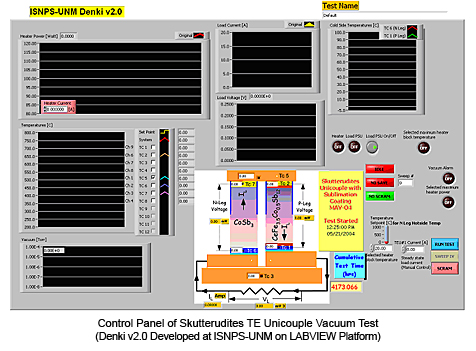
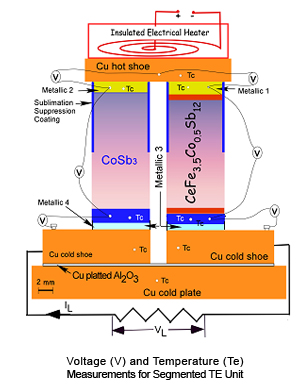
Denki can control tests in various ways. The heater power profile can be specified as a function of time, or a thermocouple reading can be set at specified temperature values. For example, the electrical power to the heater can be automatically adjusted to keep the hot side temperature of thermoelectric devices under test constant, while varying the load current during a current-voltage (I-V) sweep. The control software collects and saves data automatically during performance tests at specified intervals (seconds, hours or days). The cold junction temperature of the TE devices being tested is controlled using a refrigerating / heating bath circulator, with temperature control in the range of 25 oC to 150 oC. Higher cold side temperatures up to 400–500 oC are also possible.
The first facility shown below is a general-purpose vacuum test stand designed to test large-scale assemblies or devices. This facility has a large glass bell jar, 18 inches in diameter and 30 inches high, and its own ion pump (230 l/s capacity down to 10 -8 Torr). This facility is equipped with a HP3497 multi-purpose data acquisition/ control unit for voltage and temperature measurements, a 4-channel Tektronic TDS420 digital oscilloscope for very fast transient measurements (~150 MHz), a CAMAC digital interface system, and other auxiliary digital multimeters. The data acquisition/ control unit, the digital oscilloscope and the CAMAC system are connected and controlled by a computer via GPIB (IEEE-488).
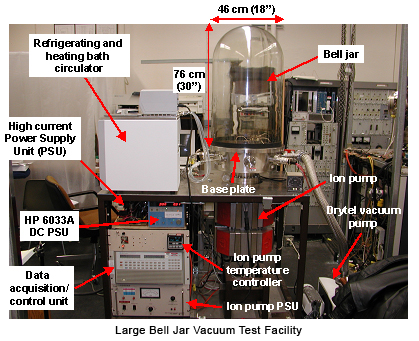
Our TECL engineers and researchers have accumulated a great deal of experience inperforming vacuum tests of TE and Thermionic (TI) converters at elevated temperatures up to 1800 K.
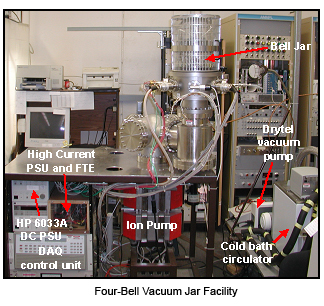
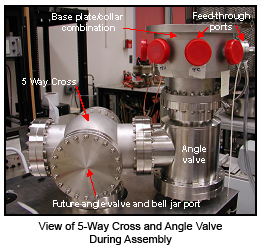
The second vacuum facility shown on this page is a four-bell jar system, for testing a number of devices simultaneously, but at four different conditions. The four glass bell jars are 10 inches in diameter and 12 inches high. This facility has its own vacuum ion pump (500 l/s capacity down to 10 -8 Torr). Each bell jar has its own angle valve to isolate it from the rest of the system, for operating at different conditions (hard vacuum or argon, environment, for example) for intermittent examination of test articles, or replacement with new articles while continuing the tests in the other three bell jars.
The articles in each jar can be independently controlled using the existing HP3852A multi-purpose data acquisition / control unit for voltage and temperature measurements. The fully assembled four-bell jar vacuum test facility is shown below.

Experimental Pool Boiling Facility
The experimental pool boiling facility at the Institute for Space and Nuclear Power Studies is dedicated to investigating immersion cooling with dielectric liquids on porous graphite and finned surfaces with the application toward electronics cooling applications. Systematic investigations are carried out using different boiling flat and finned surfaces (copper and porous graphite), at different liquid subcoolings (0° K = ΔTsub = 30° K), and at different surface orientations (0° = q = 180°), using both FC-72 (C6F14) and HFE-7100 (C4F9OCH3) dielectric liquids.
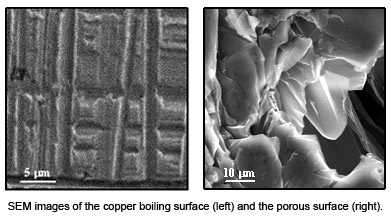
A computerized system controls the experiments and records the boiling curves up to the critical heat flux. A high quality digital camera and a high quality digital video camera record the boiling at the surface in experiments as they run. This boiling visualization greatly aid the study of the hydrodynamics of the boiling process from the various surfaces used.
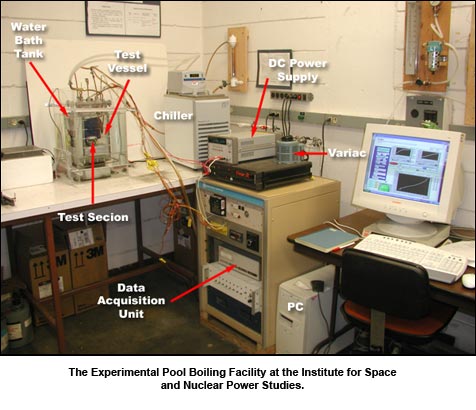
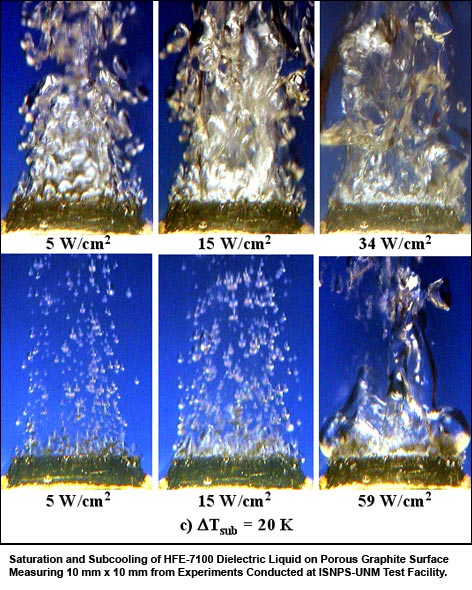
The pool boiling facility has two separate test stations capable of running experiments independently. Each station is fully equipped with its own test vessel, chiller, power supply, and computer controlled data acquisition system. The boiling surface and heater are mounted onto a Teflon block to ensure that all the power, generated by a 200 W power supply (Agilent E3634A), is dissipated through the boiling surface. The chiller (Thermo NESLAB RTE-7) is capable or removing up to 500 Watts of heat and together with the external water bath help to maintain the liquid bulk temperature to within ± 0.5K of the desired temperature. A control program developed using the LABView software runs the experiments as well as updates the boiling curve during the experiments and records the data onto the computer's hard drive for further analysis.
 Back to The Top
Back to The Top 


